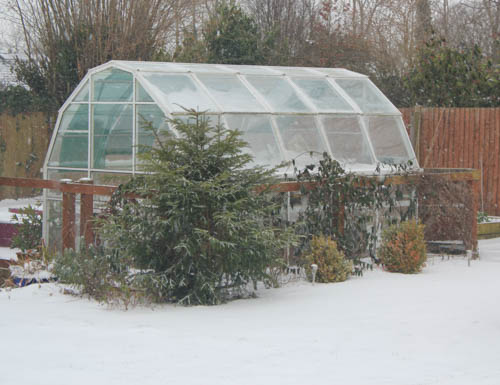
If you didn’t have time in the autumn, transplant conifers and evergreens later in the month, when soil temperatures rise. Dig round the plant just beyond the spread of its branches, cut carefully through any larger roots with a pair of old secateurs, keeping root damage to a minimum. Once the root ball is free, slide a sheet of hessian or polythene underneath it, lift it from the hole by the four corners and tie them round the trunk, to wrap the rootball. If the plant is large you will need some help to move it to its new location. Dig a planting hole slightly larger than the rootball, fork compost into the ‘backfill’ and sprinkle the roots with mycorrhizal fungi before planting at the same level it was previously.
Later in the month you can wake tender fuchsias from their winter rest. Move them into a moderately warm greenhouse and mist with tepid water once or twice a day. At the first signs of new growth, give them a little tepid water, increasing the amount as more growth appears.
As peaches and nectarines flower early in the year when there are few insects about, hand pollination is the only way to guarantee a good crop. It works best after two or three dry warm days when most of the flowers are open. To check if the time is right, run your fingertip over the anthers and there will be a dusting of pollen on your finger. Carefully transfer the pollen from the anthers of one bloom to the stigma of another, using a soft camel hair, artists brush, rabbits tail, or piece of cotton wool on a matchstick. Do this over several days to ensure that all of the flowers are pollinated, then look forward to a luscious crop in the summer.
Now’s the time to encourage dormant tuberous begonias into growth. Put them in trays and cover them with equal parts John Innes no2 and peat substitute, making sure that they are concave side uppermost. Water them in with tepid water – fungicide solution, then cover with a sheet of newspaper and keep around 16-18C (60-65 deg F) until the first shoots appear, then remove the newspaper and keep them in the shade. If you can’t provide heat, wait until late April and start them off in a cool greenhouse.
To keep Buddlea davidii, under control and guarantee plenty of flowers, cut back last year’s growth to within 1-3 buds of the old woody base and one or two of the oldest woody stems.
Once winter heathers have finished flowering, a quick trim over with the shears will keep them neat and remove the old flower heads. Avoid, cutting back into the older wood and make sure you trim them at different heights to give a more ‘natural’ look. After pruning, a scattering of slow release fertiliser at 2 oz a square yard and mulch to a depth of 5cm (2”) this will encourage vigorous growth and keep your plants healthy through the growing season.
Happy gardening. Matt


